In the 21st century, some homes still have apartments where time seems to have stopped fifty years ago. There is still much debate about that era – some designers consider it tasteless, confusing, and inconvenient for living. It was a time of flourishing subcultures like punk and hippie, disco music, and the emergence of color TVs. 70s-style interiors are becoming popular again, practically reclaiming leading positions in some countries.
Features and Characteristics of the Style
While people in Asian countries today tend to prefer high-tech, minimalist interiors, in Europe and America, finishing “in nostalgic antiquity,” old but still sturdy and beautiful furniture from that era, is fashionable and expensive. The retro style, also widely known in the USA, gained particular popularity during this era.

This style is rich and daring, bright and elegant, combining charm and kitsch. When recreating this design at home, it’s important not to overdo the decor and accessories – the interior should not look vulgar or excessive, but still be recognizable and not hinder relaxation. Personalization marked this period, with interiors no longer adhering to standardization but instead catering to an individual’s specific interests and hobbies.

Around this time, high technology in home design became popular – interiors began to feature numerous household appliances that were quite different from modern ones. These included small round refrigerators, large and rough microwaves, voluminous kitchen processors made of bright plastic, heavy vacuum cleaners, huge computers with small screens, even larger reel-to-reel tape recorders, washing machines that looked like spaceships, and wooden radios on legs.





Bright Colors and Accents
The color palette of the 70s style is similar to boho – there are practically no restrictions on the choice of shades. There are many natural, rainbow colors, and acidic hues. When designing small rooms, light tones are the go-to choice, while larger, spacious rooms often see the use of darker tones. Interestingly, window orientation also influences color selection. Windows facing south call for cool colors, while those facing north benefit from warm tones.
Some of the most interesting color combinations include:
- Sky-blue with acid-green
- Pebble with coral
- Strawberry with iron-gray
- Brown with bottle-green
- Pumpkin-orange with sunny-yellow
- Gold with purple
- Wood-brown with pink
- Beige with violet-black
- Mustard with denim-blue
- Snow-white with crimson
- Cherry with cornflower-blue
- Willow with orange.

As a rule, the 70s style interior is decorated with a maximum of two or three main colors, but there are plenty of small color accents that help maintain a clear stylistic direction.

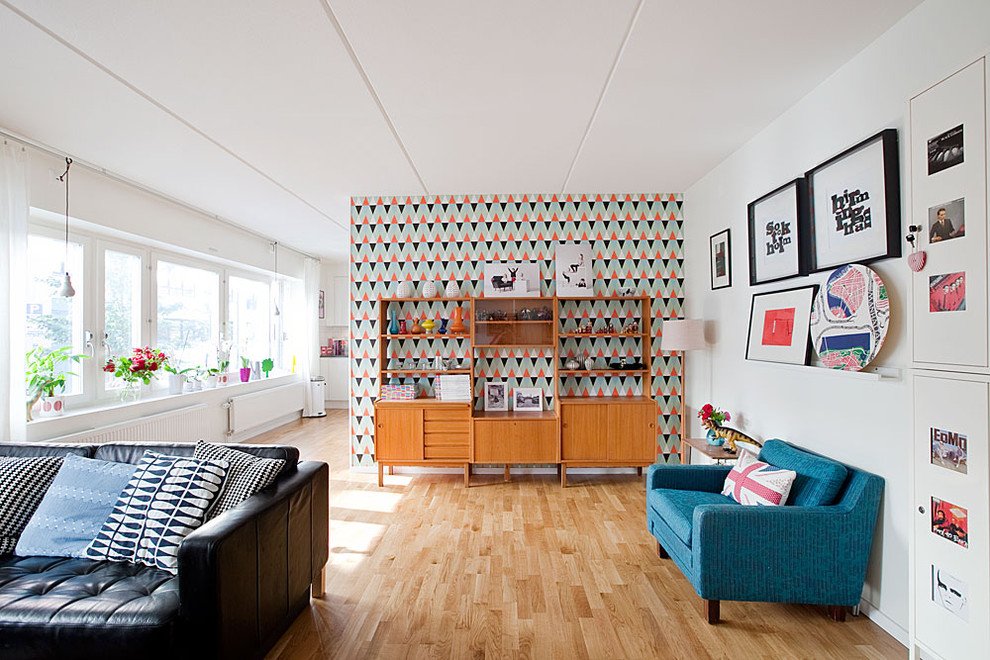



Materials and Finishing
The finishing materials used in the 70s style interior are quite diverse and include:
- Metal
- Wood
- Particleboard
- Plastic
- Glass
- Plywood
- Leather
- Stone
- Vinyl
- Paint
- Wallpaper.

In a 70s style interior, the flooring usually features planks or inlaid parquet crafted from various types of wood such as oak, beech, ash, walnut, larch, birch, juniper, maple, pear, or ash. Occasionally, laminate serves as a budget-friendly option that mimics the appearance of natural wood flooring.

The 70s style also extends to the walls, which often showcase wood decoration or brown or gray-gold paint. Alternatively, wallpaper with geometric or botanical patterns and rich texture may cover the walls. The ceiling typically gets a coat of white paint or a high-quality stretch ceiling finish that simulates whitewashing. Plasterboard painted white can also serve as a ceiling material. Some decorative ceiling moldings are acceptable, but they shouldn’t be too abundant.
The doors in this style tend to be tall, nearly ceiling-high, and may be double-leafed. Colors range from white-blue to silver-gray or violet tones. The windows, typically made of wood, often feature a coat of white paint.

The most commonly used flooring in this style is parquet, which is typically finished with varnish or painted with semi-transparent paint.





Furniture Selection Features
Furniture in the 70s style is sleek, very shiny, and somewhat surreal, and asymmetric shapes are welcome. The preferred materials are dark-stained oak wood, bronze, brass hardware, plastic decorative elements, and even wicker furniture. Soft furniture such as cozy sofas, bentwood chairs, and chairs with upholstered seats and carved backs are preferred. Upholstery is usually bright, but more “solid” colors such as graphite-gray or chocolate-brown are also acceptable.

In the 70s, brightly colored plastic, such as polypropylene, was first introduced in interiors. Round dining tables with chairs, children’s furniture, and original stands for indoor plants were made from this material. This type of furniture is very elegant and comfortable.





Abundant use of textiles
In the 70s interior design, carpets play a significant role. They are plush, lavish, and cover nearly the entire floor and up to 40% of the wall surfaces. Colorful intricate patterns embellish floor rugs, while wall hangings, including tapestries, depict fantastical animals. The hallway features a “runner” with stripes on the edges, and various “floor cloths” are in the kitchen, balcony, and bathroom.
Curtains, which are thick and almost floor-length, provide protection from the cold and daylight. Textiles come in various colors but share a similar pattern and texture. Materials such as fur, velvet, velour, natural wool, and leather are popular. On all horizontal surfaces, it’s acceptable to have a plethora of multicolored pillows, tassel and brush adorned throws for soft furniture, along with numerous lace tablecloths and napkins. Textile panels beautify the walls, and homemade wicker baskets with live plants in vases sit on windowsills.

Well-preserved textiles can only decorate a modern interior if they look impeccable.


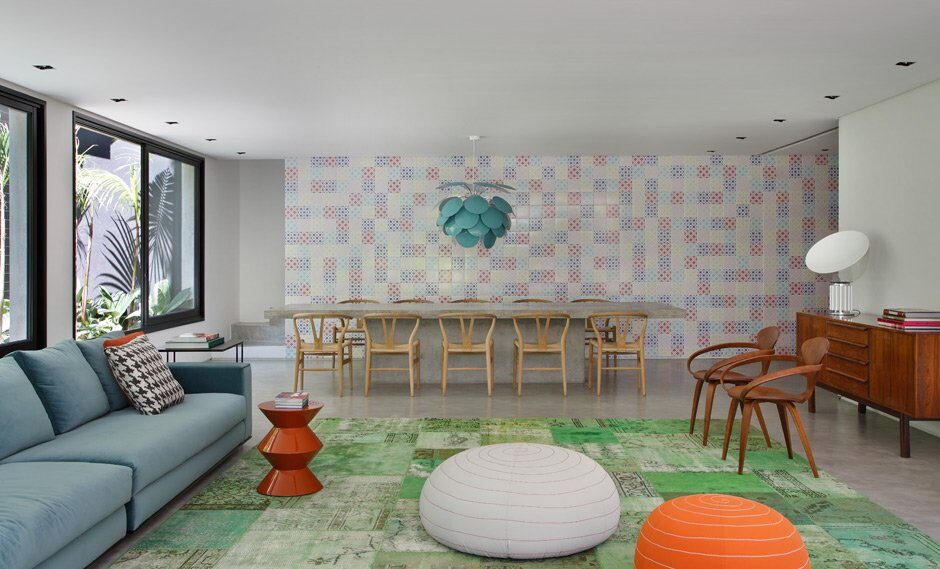


Retro lighting
The lighting is usually uncomplicated, but the fixtures themselves look luxurious – these are crystal, pseudo-crystal multi-arm, multi-level chandeliers, tall floor lamps with fabric lampshades on turned legs, intricate wall sconces. They are accompanied by small decorative lamps of surreal shapes – lava lamps and plasma lamps. Work areas in the kitchen, office, and children’s room are brightly lit with lamps on long flexible stems with a shiny metal shade.

If desired, an original lampshade in macrame or knitted lace technique can be made for any lighting fixture – all you need is a suitable wire frame.





Example of modern apartment design
Modern times imply different interior priorities than 50 years ago. Nowadays, no one would think of covering a flat-screen TV with a white lace doily, and it’s unlikely that a whole room would be devoted to a library, since any book can be easily downloaded from the internet. Therefore, the interior design of those times was quite minimalistic – it was easier to maintain cleanliness in such an environment.

The decor here is quite diverse, from abstract paintings in rectangular frames to colorful posters featuring stars of foreign pop culture from the 70s.




Entryway
In a 70s style entryway, a large mirror with three panels often adorns a peculiar dresser-like table. While it can be relatively spacious, it often takes up a significant amount of space. In case of a smaller room, a simple mirror in a basic dark wooden frame replaces the dressing table and is hung on the wall.

When there’s a landline phone in the house, it typically showcases an original design – either a bright plastic model in acidic colors or one with a metallic casing. This phone usually sits on a small shelf positioned near the mirror. In addition, a wooden hanger for outerwear is commonly found in this space.


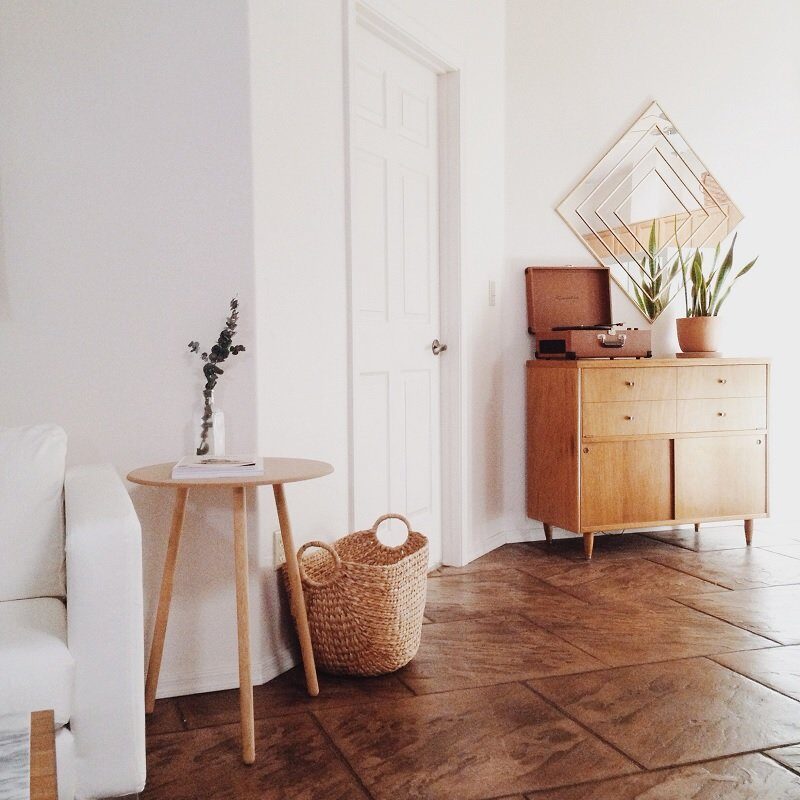


Living Room
The living room typically features a wall unit that occupies an entire long wall. This unit can store a multitude of items – a vast collection of books, elegant dishes used on special occasions, certain clothing items, and small household appliances. For a modern interior, opt for a spacious wall unit with a central shelf for a TV. Display only the most aesthetically pleasing books with vibrant covers, and arrange them by height. While you can keep some dishes on the glass shelves, avoid storing too many to prevent the space from looking cluttered.
Position a soft, usually foldable, sofa and two “Scandinavian” legged chairs opposite the wall unit. A mobile coffee table or one with four cone-shaped legs can sit almost at the center of the room. Neatly place a real piano in the corner – in contemporary times, you can create a small podium for it. If necessary, you can use curtains or folding screens for zoning. Consider using a geographic map or a real globe as a decoration.
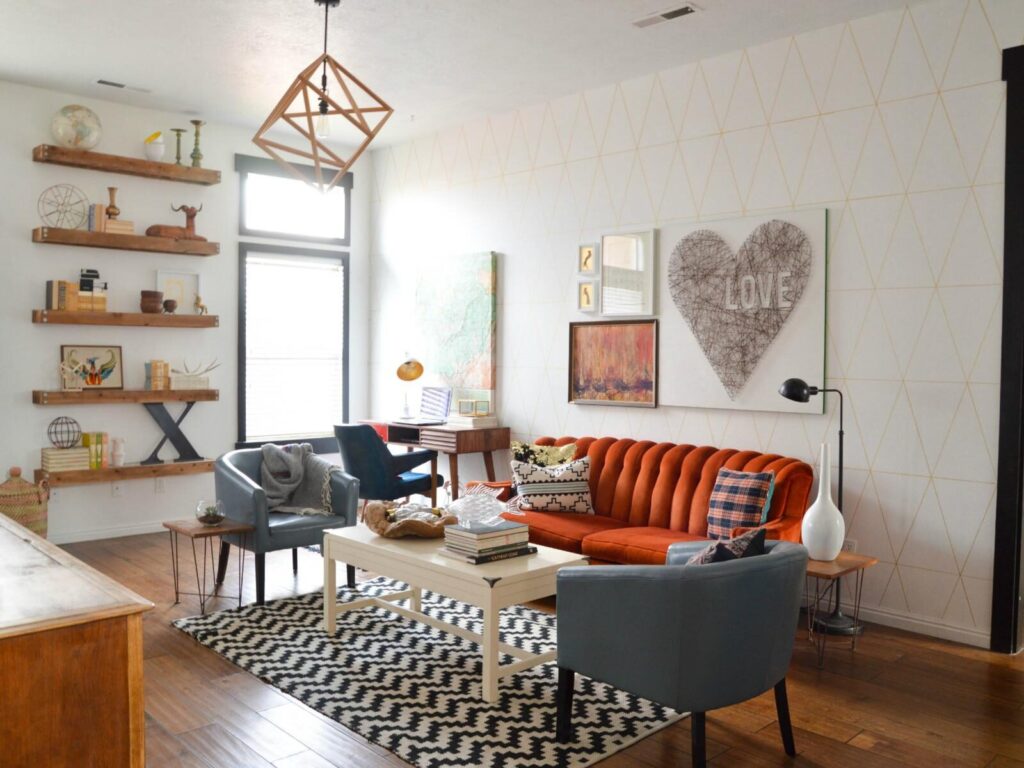
Instead of a wall cabinet, sometimes shelves are installed up to the ceiling, and a bookshelf separates a small home office with a writing desk.


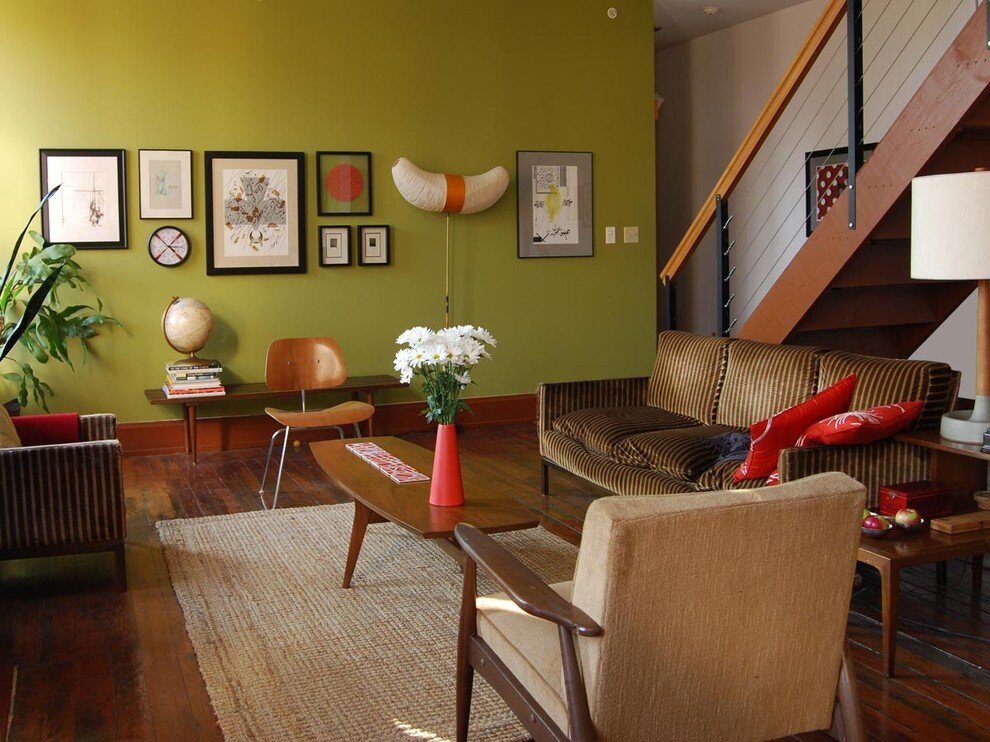


Kitchen
An indispensable item in the 70s kitchen was a sideboard. It was painted white or bright colors and held the bare minimum of dishes and tableware. The kitchen set was typically white, blue, or occasionally red or purple with a clear geometric shape and rough metal decor.
Adorn the dining table with a checkered or brightly colored oilcloth tablecloth, lit by a round chandelier with fringe. Consider a foldable dining table in a “book” style for accommodating guests. Decorate the dining area with a series of narrow shelves displaying items like painted dishes and brightly colored spice jars.

Lay large ceramic tiles with black-and-white or black-and-green patterns on the floor. Paint the walls with light-colored paint and tile the backsplash with small, colorful tiles.
Choose kitchen appliances in a vintage style, featuring round shapes and substantial iron handles. Keep them subtly incorporated – hide anything excessively modern behind cabinet doors.





Bedroom
Position the bed with a bedside table sideways against the wall in the bedroom. Hang a wall lamp with a frosted glass flower-shaped lampshade above the bed. In smaller bedrooms, substitute a full-size bed with a sofa that acts as a daytime seating area and unfolds for sleeping at night. Choose bedding exclusively in light, solid colors or with stripes, adding delicate embroidery in some places.
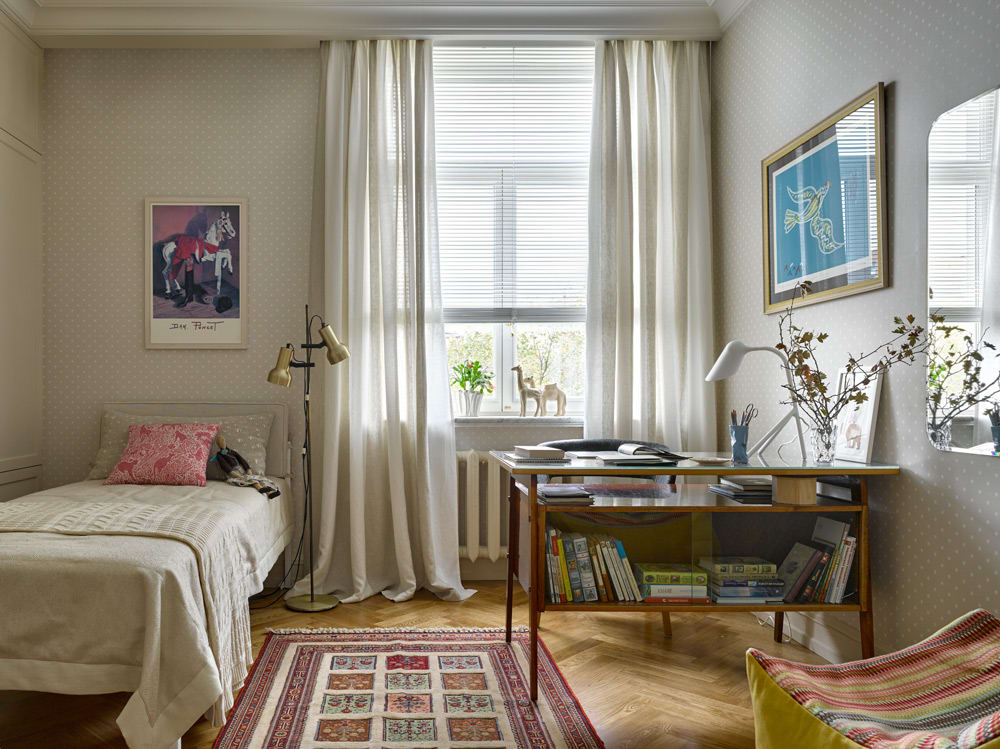
For the dressing area, place a two or three-door wardrobe with polished doors. Store outerwear on a hanger on one side, and bedding and underwear on the other. If desired, place a wooden floor-standing hanger with hangers next to it. Hang a wooden shelf with metal wires on one of the walls. You can display books, potted plants, homemade toys, and black and white photographs on this shelf.





Bathroom
Often, the bathroom and toilet are combined in a 70s style interior. The walls typically feature white solid-color tile or tile with a geometric pattern, while the floor is usually darker. All plumbing fixtures tend to be white, but you can also opt for artificially aged yellow-brown fixtures if you prefer. The bathtub typically rests on brass or copper legs with a matching faucet.

Unnecessary items are avoided in this style. If there’s enough space, a vanity table with a mirror might be placed in the room. Under the bathtub, you’ll often find closed shelves. Any decor is practically absent.





Conclusion
A full-fledged interior design in the style of the seventies is quite simple and inexpensive, especially if you decide to recreate it in an old apartment built in the middle of the last century and still have not quite worn-out furniture. While some modern apartments and country houses occasionally incorporate elements of this style, high-quality stylization tends to be more expensive, and the furniture is usually custom-made.






Leave feedback about this